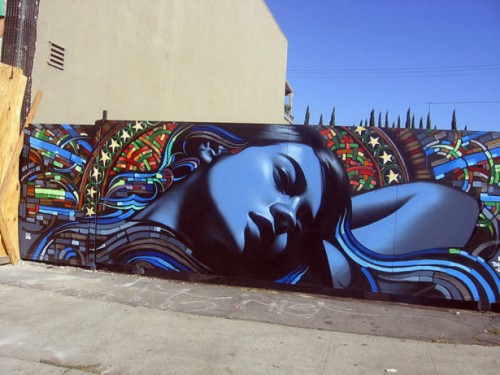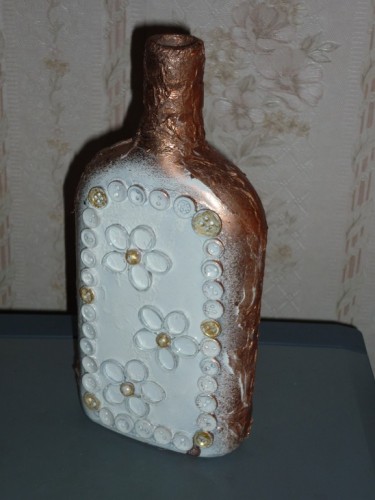
Aerosol paints. Features, choice, use paints and varnishes

The aerosol paint in a special cylinder is convenient to apply paintwork material used for painting furniture, metal and plastic parts of cars, household appliances and many other things.
Content
The paint sprayed from the balloon is a uniform layer allows you to perform:
- restoration work;
- decoration of various items;
- create images using a stencil;
- paint various surfaces;
- create graffiti.
Advantages and disadvantages of aerosol dyes
Aerosol paints are characterized by a number of distinctive qualities.
- Aerosol paint is ready for use: Before spraying, it is enough to shake the spray several times.
- Such paint is indispensable for staining of small and hard-to-reach surfaces: splashing particles penetrate and covered in any small recesses.
- Work with such paints is performed without auxiliary tools (rollers, brushes).
- It has good adhesion with surfaces from various materials.
- It quickly dries, is not subject to fading and destructive influence of ultraviolet radiation. Resistant to abrasion.
- Easily transported for a long time.
- It is possible to choose aerosol paint of any type. Distinguish: Oil, acrylic, heat-resistant, latex, epoxy and others.
- The colors of the paints of aerosol are distinguished by a large variety, so that you can easily choose the required shade.

- The decorative features necessary for artists-investors. There are paints with a hammer effect, pearl, imitating metal surfaces, fluorescent, possessing a different texture (glossy, semi-man, matte).
- The ability to create smooth transitions from one color to another.
- Cylinders with not fully consumed paint are better stored than banks: paint practically does not dry into them. Thanks to hermetic, cylinders do not exude the smell.
There are disadvantages:
- you can not mix paints of different colors;
- using skills are needed: due to the too large volume of superimposed paints, drips are formed;
- to obtain a clear boundary, a painting tape or stencil is used;
- it is impossible to reduce the delicate of paint by adding the solvent;
- special requirements for external conditions when applied: it is necessary to work in light weather.
Tips for choosing aerosol paint
In order for the painted surface for a long time retained an attractive look, you must choose the right paint. Using the following tips.
- The choice of paint depends on the material to be stained. The paint aerosol for plastic, glass and wood is made on the basis of acrylic, zinc aluminum paint is needed for metal. Ceramic products and enameled baths are covered with epoxy enamels.
- In order to properly pick up the color of the paint, it is recommended to use special catalogs like NCS, RAL.
- If you wish, in accordance with the common interior style (or product), you need to select the effect for the surface to be painted. This may be imitation dents from the impact of a chased hammer, a pearl, fluorescent effect either the effect of metal glitter.
- Using the information on the flow rate of 1 m² (indicated on the label), the total amount of material is calculated, taking into account the application of it in 2-3 layers.
Application technology of aerosol paint
Buy aerosol paint suitable for the stained material is not enough. You should act in accordance with certain rules to get a good result.
- To prevent aerosol poisoning, you need to stock up with a respirator, the eyes protect special glasses or a mask.
- The surface to be stained is necessary to prepare: it is purified from dirt and degreased with acetone or alcohol.
- The surfaces of porous materials are treated with an aerosol or ordinary primer.
- Neighboring surfaces should be protected by painting scotch with random staining. With you, you need to have a clean cloth, which can be wiped (if necessary), not yet dried paint.
- The paint can be used to shake several times before applying that the contents have acquired a uniform consistency. Test staining is performed.
- The balloon is sent to the nozzle in the direction of the stainable material and keep at a distance of about 25 cm from it. Spraying paint, move the spray from the side to the side so that the pigment is superimposed on the surface evenly in 2-3 layers. At the same time, it is important to prevent the dose of: the excess paint can cause the formation of flops.
- Working outdoors, you should choose dry and mad weather, preferably cloudy.
- The product painted (if possible) is oriented horizontally. The vertically located surface is covered with paint from top to bottom. This reduces the likelihood of flows.
- There should be a pause in half an hour between each application of the new layer: during which time the previous layer of paint will have time to "grab".
- The product must be completely dry. Depending on the composition of the paint and environmental conditions, it will be required from several hours to days.
- It is possible to fasten the painted surface using acrylic varnish.
Important: Aerosol paints must be sprayed away from open fire. A mixture of chemicals with air is easily flammable. In order to obtain a better surface, it is recommended to use primer, aerosol paint and varnish of one manufacturer. They interact well with each other.
About some types of special aerosol dyes
Aerosol paints for metal
- Water-based ecoemali for external and internal work. Features of the composition allow you to quickly apply it, after which the paint dries quickly. If the adjacent surface was erroneously painted, it can be cleaned with clean warm water for half an hour. After drying, the ecoemal turns into a durable coating that protects the base from ultraviolet. The quality of the dye can be determined by the smell of vanilla.
- Paints for metal surfaces. There are three types of such aerosols. First include standard dyes, intended only for the desired surface shade. Another species is double paint, which also contains primer. This composition saves time and materials: there is no need for a special preparation of the base.
- Troin's aerosol paint: In addition to paint and primer, a rust converter is added to it. Before staining such a paint metal is enough to clean with a rigid brush or sandpaper.
The aerosol dyes listed above have the following advantages, which highlights them from a number of other paints for metal:
- with their help, it is possible to accurately perform color, including difficult accessible sites;
- economical consumption: paint is applied with a thin layer;
- are a good tool to protect against an external aggressive environment.
Paint heat-resistant aerosol
Paints are manufactured with such properties based on silicone substances. They include pigments, polymer additives (containing flint and oxygen) and fillers. Such paints are designed to protect the surfaces of various materials from the effects of the aggressive outer environment - precipitation, steam and chemicals. They are distinguished by wear resistance and resistant to high temperatures.

Heat-resistant paints in the form of aerosols are used as follows.
- As a coating for metal, wooden surfaces, ceramic brick, concrete - to protect against exposure to external destructive factors.
- For staining of various heat engineering equipment (fireplaces, furnaces, boilers, etc.), parts of engines, building structures.
- Heat-resistant paints with light burst properties are used to design road signs, for staining some types of dishes, fire protection equipment.
- For staining surfaces in rooms with hot steam (boiler houses, saunas, pools).
Important: The heat-resistant paint is applied at temperatures from -15 to + 40 ° C. Air humidity and temperature affects its drying, which is at least two weeks.
Paint for plastic
It is used in different fields of industry, for example, in the automotive industry. Paint for plastic is resistant to abrasion, to household chemicals and moisture. The painted surface may be velvet, glossy or rough.

There can be different in the composition of the aerosol paint: it depends on its technical and operational characteristics. This affects the covers, that is, the consumption of material on the color of the unit unit. The following colors are distinguished for plastic.
- Polymer or polyarilated (ABS) are characterized by good adhesion, contain primer, according to the characteristics are similar to enamel. For example, the paint is an aerosol acrylic: designed for staining similar to the composition of products.
- Abrasion-resistant - are created on the basis of polyurethane resins. After their use, the surface acquires a glossy look.
- Structural: Designed to cover the small surface irregularities and have high thixotropy. Plastic covered with such paint becomes smooth.
- "Soft Touch", or tactile paints, creating a velvet effect. The basis is acrylic polyurethane.
- Paints for polychlorvinyl: Thanks to adhesive impurities, it is stably kept on the surface and protect them from ultraviolet and other aggressive effects.
- The monad paint for polyvinyl chloride is created on the basis of modified alkidompolyivinyl chloride resins.
Aerosol paints for decor
For decorative purposes, aerosol paint RAL shades can be used, each of which is denoted by its number. The selection is carried out using a special palette table. The paint should be combined in its composition with the base stained. For example, Bosny paint aerosol is very popular with graffiti lovers.
Often paints for the decor are used for designing cans, flashes, double-glazed windows.
The aerosol paint for glass allows you to create complex drawings using a stencil or geometric - with a painting tape or tape.
Glass block coloring technology consists of several stages.
- The glass is purified by household detergents and wipe dry.
- Painting scotch tape limit the area of \u200b\u200bstaining.
- The glass is degreasing with alcohol, after which they try not to leave fingerprints.
- Paint is applied with a thin layer from a distance of about 25 cm.
- After 20 minutes, the next layer is applied if necessary.
- 40 - 45 min. Remove scotch.
Similarly, they do when applied geometric pattern on glass or glass dishes. To do this, you can use scotch of different widths or pre-made stencils. If you need to use two colors - you should close with a tape fully dried previously colored fragments, after which you can continue to apply the drawing.
Useful advice
- To remove rust from the surface of the metal, you can use household chemicals - food soda or wine vinegar before painting. They are applied with a brush, and after 30-40 minutes. Washed off with water.
- A smooth surface is required to make a rough (using sandpaper). This contributes to the best adhesion of paint.
- Polished wood before painting should be treated with grinding machine. The resulting dust is removed with a dry cloth.
- The painted object is recommended to leave for several days in a non-residential room to eliminate odor.
Summing up, it should be noted that thanks to practicality, low cost and rich selection, aerosol paints have acquired well-deserved popularity. They are indispensable with small repair and decoration.
In conclusion - video tutorial, clearly demonstrating aerosol paint techniques.




